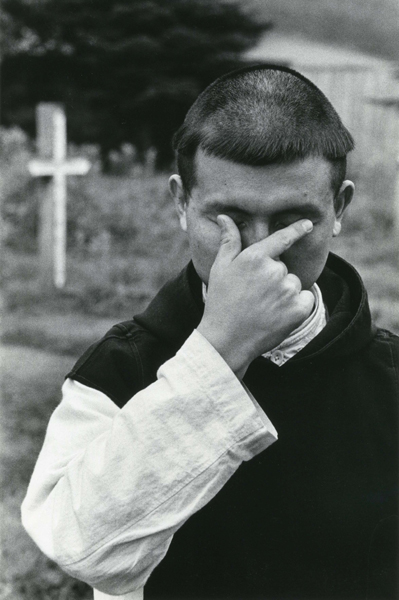 |
 |
|
|
Photographers of Japan Vol.13 "Narahara Ikko - Double Vision "
Narahara Ikko was born in 1931 in his motherfs hometown of Omuta City, Fukuoka Prefecture. His fatherfs position as a court judge kept the family moving around the country, leading Narahara to have a boyhood with no stable place to belong. After beginning his activity as a photographer, Narahara traveled the world, staying in parts of Europe and the USA for long periods at a time but continuing to move around and around, perhaps affected by the experiences of his youth.
Narahara held his first solo exhibition, gHuman Landh (Matsushima Gallery, Tokyo), in 1965. It put side by side the island of Hashima (also called Gunkanjima), a manmade island off the coast of Nagasaki created to support a coal mine, and Kurokami Village, a small village at the foot of the active Sakurajima volcano, presenting a dichotomy between gman versus societyh and gman versus natureh. This debut exhibition had a deep impact, turning a simple graduate student studying art history at Waseda into a notable young photographer by the end of its course.
His 1958 solo exhibition, "Domains" (Tokyo, Fuji Photo Salon), was also a product of notions of dualism. The comparison of a menfs monastery in Hokkaido (Land of Silence) and a womenfs prison in Wakayama (Within the Walls) approaches themes of polarization like man/woman, religious/secular, free will/force. The works in these two series approached the question of what is necessary for human life in confined space.
In 1959 Narahara collaborated with Tomatsu Shomei, Hosoe Eiko, Kawada Kikuji, Sato Akira, and Tanno Akira to create the photographerfs group VIVO; together, they created what was one of the brightest seasons in the history of Japanese photographic expression.
After the disbandment of VIVO in 1961, Narahara based himself in Paris and traveled Europe from 1962~1963, then settled in New York from 1970~1974. He published several series in the following years, such as gWhere time has stopped - Europeh (Kagoshima Kenkyujo Shuppansha, 1967), gEspana: Grand tarde, Fiesta, Vaya con Diosh (Seiryudo, 1969), gJapanesqueh (Mainichi Shimbunsha, 1970), and gWhere time has vanishedh (Asahi Shimbunsha, 1975); these works showed the development of his gdouble visionh that saw both the external and internal at the same time, a concept which matured over he spent time between Japan and the West.
Narahara continued his search for gspectacles where outer reality and the realm of the inner domain of the heart meet and become oneh throughout and after the e80s, creating many diverse photo works. Itfs significant that the last work Narahara has presented is called gDouble Vision - Parish (2000~2002). Seeing the photos of Paris that he printed slightly staggered one over the other, it is possible to understand the way he might see the world.
 Ikko NARAHARA From the seriesDomains: "Garden of Silence (2)" 1958 (printed 1984) Gelatin silver print Image size: 47.8~31.5cm Sheet size: 50.8~40.6cm BacknumberVol.16 "Ogawa Takayuki (1938 - 2008) âEexplorer of âshapeâEthrough photography"Vol.15 "Kitai Kazuo - Capturing âa scene I once sawâ¦âE Vol.14 "Kazama Kensuke" Vol.13 "Narahara Ikko - Double Vision" Vol.12 "Q Ei and Vol.11 "Fukuhara Shinzo 1883-1948 -- Japanese Landscape Photography" Vol.10 "The city observerfs gaze Akihiko HIRASHIMA (1946~)" Vol.9 "Hitoshi FUGO 1947- -- The unusual world of works which fuses thought and technique" "ETSURO ISHIHARA - THE EXTRAORDINARY GALLERIST WHO TURNED PHOTOGRAPHY TO ART" Vol.8 "Iwata NAKAYAMA (1895-1949)" Vol.7 "KISEI KOBAYASHI (1968-)" Vol.6 "Tamiko NISHIMURA (1948-)" Vol.5 "Shigeo GOCHO (1946-83)" Vol.4 "Shoji UEDA -Locality open to the world-" Vol.3 "Yu OGATA, ICHIRO OGATA ONO -Dyslexia's picture of the world-" Vol.2 "Eikoh Hosoe's theatrical imagination" Vol.1 "maroon" -- Whereabouts of new works by Hiroshi Osaka
|
| Gallery TOKI NO WASUREMONO / WATANUKI INC. LAS CASAS, 5-4-1, Hon-komagome, Bunkyo-ku, Tokyo 113-0021 JAPAN Tel +81-3-6902-9530 Fax +81-3-6902-9531 E-mail:info@tokinowasuremono.com http://www.tokinowasuremono.com/ Open Tuesday-Saturday 11:00-19:00 Closed on Sundays, Mondays, National Holidays Copyrighticj2012 TOKI-NO-WASUREMONO^WATANUKI@ INC. All rights reserved. |